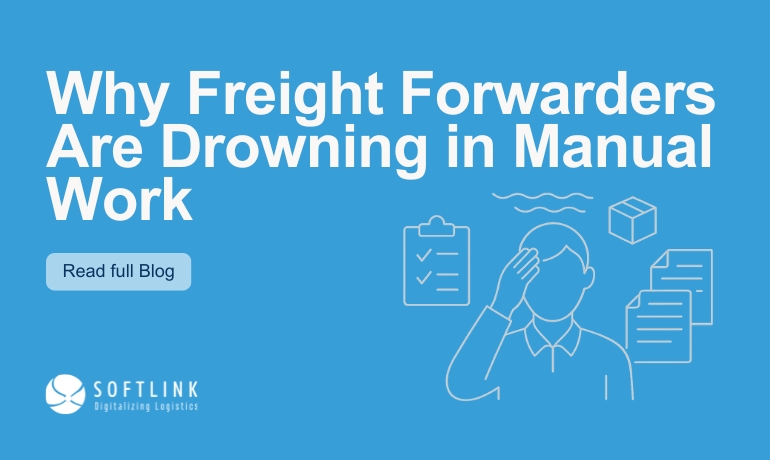- By Softlink Global
- July 15, 2025
- General
Manual Systems: Still Too Common in Freight Forwarding
Despite advances across global logistics, a surprising number of freight forwarders continue to depend on manual workflows and disconnected systems. Whether it’s managing quotes in spreadsheets, emailing shipment updates, or filing customs through standalone portals, these methods are still embedded in daily operations.
For smaller firms, this may feel manageable—until shipment volumes increase or customer demands rise. At that point, the limits of these methods quickly become clear. Without automation and integration, forwarders spend too much time tracking data, duplicating effort, and firefighting issues.
The Operational Drag of Fragmented Systems
Several operational challenges emerge when freight processes are driven by manual or semi-digital systems:
- Disjointed communication between departments delays handoffs and creates silos
- Charge capture is inconsistent, leading to revenue leakage across jobs
- Shipment visibility is fragmented, forcing teams to rely on emails or calls
- Customs compliance is handled externally, increasing filing errors or delays
- Job updates are manually entered, slowing down reporting and client communication
Each of these problems contributes to a larger issue—forwarders become reactive rather than responsive. Teams spend their time correcting avoidable mistakes, chasing updates, or reconciling numbers, instead of focusing on growth and service improvement.
Learn more from our experts how you can digitalize your freight forwarding & logistics business.
Legacy Systems Don’t Bridge the Gap
Many forwarders have made some investments in digital tools over the years—perhaps a freight application here, an accounting tool there, and maybe a separate CRM system. But these aren’t always integrated, and more often than not, the data doesn’t flow between them.
The result is a patchwork of platforms that still require manual re-entry of data. For example, a sales quote created in one system has to be manually copied into the freight module. Charges entered by operations might not reflect in the billing ledger. Shipment milestones need to be updated separately in customer emails or external portals.
This fragmented model prevents forwarders from accessing real-time data across their business. It also creates gaps in accountability, accuracy, and service consistency.
Modern Freight Systems Are Built for Cohesion
Today, forwarders need more than automation—they need cohesion. A purpose-built freight management system ensures every workflow is connected: from customer acquisition and job booking to compliance, billing, and delivery.
Here’s what modern freight forwarding software enables:
- Centralized data management, where job details, rates, documents, and communications are stored and updated in one place
- Built-in compliance tools, allowing customs filings like e-Sanchit or ICEGATE directly from within the platform
- Live milestone tracking, keeping both internal teams and customers updated in real-time
- Integrated accounting and taxation, enabling quicker invoicing and reconciliation without switching systems
- CRM and quotation modules, linked with operations to speed up conversion and handover
This level of integration ensures fewer touchpoints, fewer errors, and faster delivery across every shipment.
A Practical Transformation: From Workaround to Workflow
One freight company operating across Mumbai, Delhi, and Chennai had been using spreadsheets for quoting, manual ledgers for accounts, and a basic freight app for job creation. Their team often lost hours each week cross-checking data between branches and chasing approvals on WhatsApp.
After moving to a unified software for freight forwarders, their operations changed in measurable ways:
- Quotations, jobs, and invoices were all part of a connected workflow
- Branches accessed the same live data, reducing back-and-forth updates
- Customer updates were automatically triggered at key shipment milestones
- All documents—BLs, invoices, and customs submissions—were filed and stored centrally
- The management team gained real-time visibility into revenue, shipment progress, and team performance
The operational load decreased, customer satisfaction improved, and their ability to handle more shipments with the same team grew significantly.
Logi-Sys: A Platform That Enables Growth Without Compromise
For freight forwarders looking to move beyond manual operations, Logi-Sys provides a clear path forward. It is an Intelligent Cloud ERP Platform built specifically for the logistics industry—enabling full control over freight, compliance, finance, and customer service.
Logi-Sys offers:
- Multi-modal freight modules: Air, Sea, and Road—both Export and Import
- Inbuilt Customs Compliance: File directly with ICEGATE, e-Sanchit, and port systems
- Billing, Accounting & Taxation: Integrated and aligned with freight operations
- Multi-branch and Multi-country Support: For forwarders working across geographies
- CRM, Sales, and Quotation Tools: Natively connected to operations and billing
- Live Job Tracking & Dashboards: Monitor exceptions, approvals, and performance metrics
- Digital Connectivity: Seamless links with ports, shipping lines, banks, and airlines
By operating on a single database, Logi-Sys eliminates duplication, accelerates decision-making, and ensures consistency across the organization.
Whether you’re growing locally or managing international freight movements, Logi-Sys delivers the reliability and efficiency required in today’s freight environment.
From Manual to Modern: What’s Next for Freight Forwarders
Scaling a freight business today requires more than hiring more people or adding more branches. It requires systems that scale with you—without multiplying the complexity. Forwarders who rely on fragmented or outdated tools often find themselves buried in routine work, while competitors with integrated systems grow faster and serve clients better.
Investing in a modern freight forwarding software is no longer about future-proofing. It’s about meeting current demand. A connected, cloud-based freight management system gives forwarders the visibility, accuracy, and speed their clients expect.
With a unified software for freight forwarders like Logi-Sys, forwarders can finally move beyond firefighting and start building the future—with confidence.


